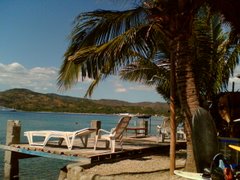Was flippin thru the channels today and saw an interesting documentary in the Discovery Channel (Our time of War.) I think it was part of a whole series, but the focus of this particular episode was the Japanese selfless bushido-influenced attack collectively lumped as the Kamikazi. Very interesting. I think ill buy a book on it. Or a pirated copy of the series in Quiapo :)
_________________________
The word kamikazi would conjure images of the Pearl Harbor, with Japanese Zeroes killing off plane after plane and crashing into the decks of the American warships. Expensive perhaps, but terribly effective.
Apparently, theres a whole lot more to the Kamikazi strategy than that.
__________________________
When the war reached the Homeland, the Japanese were at their most desperate. First of all, the entire air defense of the Homeland was based on the intelligence reports that the Americans would strike with B17s (or other bombers around that line) which flew at a max altitude of 25000 feet. However, they were attacked by the B29 Flying Fortresses which flew much higher at 30,000 feet, out of the japanese air force range, dropping with impunity incendiary bombs which razed the key japanese cities.
Faced with the dillemma, japanese ingenuity came into play. The Divine Wind, an elite airforce group (which grew more elite by the hour) specializing in Kamikazi strikes, reengineered most of the defending air units by taking out all defenses, unnecessary components and loaded them with just enough fuel to reach their targets. This allowed them to reach the heights the american bombers flew.
They were ordered to go between the bombs and their homeland. And ram into the bombers. Terribly effective, but still not enough to stop the deadly bombing runs.
A more devious defense was the Oka-11. Whereas the previous kamikazi aircrafts were simply planes loaded with explosives, the Oka was truly designed to be a suicide unit. It had no take off and landing gear and was taken from the latest german rocket designs.
The first American sorties who would engage defenses that used Okas would be amazed as to why a bomber was deployed against them. A few moments later, the bomber would release its payload of Okas and decimate the American bomber. Simple and effective.

The Oka-11. No takeoff and landing gear. Whoever pilots this is definitely gonna die.
_______________________________
They applied the same principles of kamikazi attacks on the naval battles as well. Torpedo versions of the Oka were fired at oncoming battleships and hundreds of planes were loaded with explosives for more dive bombing action.
One of the plans that almost saw action was to use the Japanese Flagship, the Yamato as the last line of suicide defense against the invading army. It considered beaching the great ship against a strategic point in the okinawa area, forming a mini-island fortress and having all its soldiers on board open fire with everything they got(sounds suspiciously like Macross/Robotech's Daedelus maneuver doesnt it?).

The Yamato, the largest superbattleship in the world. It was 62,000 tons of armor and firepower. Unfortunately, torpedoes werent in vogue when it was first designed
Fortunately for the Allied forces, it went down after a series of torpedo fire from American warships. Unmanned torpedo fire of course.
_______________________________
I heard Discovery's going to launch their "Interview with the Kamikazi pilots" series soon. Well, for me, I would love to do a Divine Wind for Dummies book sometime.
Is that a B29 Flying fortresses? Put pilot in rocket... fire
Oh, there are Aircraft Carriers? Put gunner in Torpedo... fire.
Are those Tanks? Strap explosives on civilian...
Simple eh? I mean, how do you counter kamikazi bombers? Kill them?
No wonder Truman just nuked 'em out of sheer frustration.
And as a final trivia:
When the Japanese DID surrender, hundreds of soldiers committed harakiri (ritual suicide). Now that is DEFINITELY something.


No comments:
Post a Comment